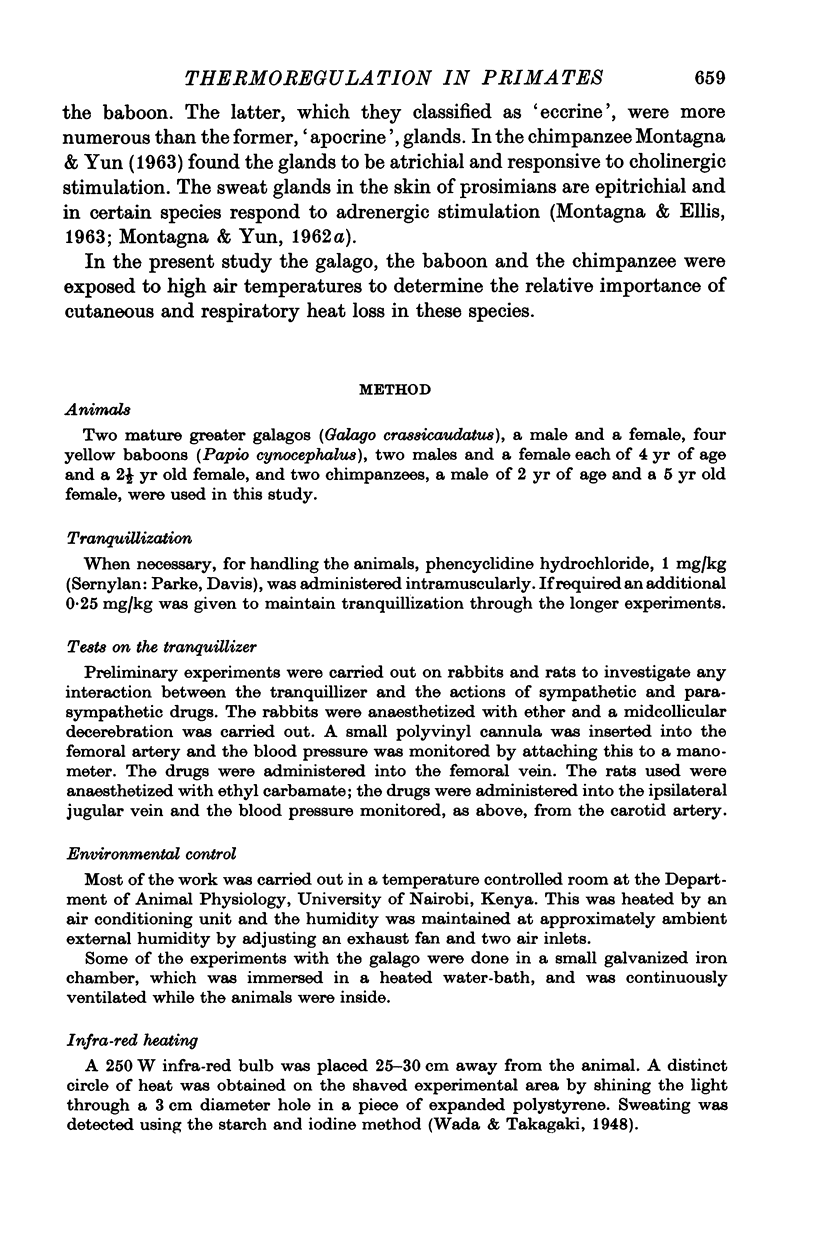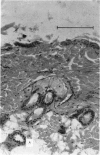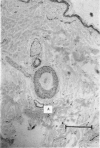Abstract
1. The thermoregulatory response of the galago, the baboon and the chimpanzee were studied on exposure to dry bulb temperatures of up to 40 degrees C in a temperature controlled room. 2. Heat exposure caused an elevation in the respiratory frequency of all three species. The increase in the galago was significantly greater than that in the baboon and the chimpanzee. 3. Heat exposure also caused an increase in the cutaneous moisture loss of the baboon and the chimpanzee but not in the galago. 4. Rectal temperatures always rose on heat exposure but the animals never become hypethermic. 5. Sweat gland activity in the baboon and the chimpanzee was stimulated by the administration of acetylcholine and was blocked by the administration of atropine. Sympathetic and parasympathetic drugs had no stimulatory effect on the sueat glands of the galago. 6. Local, infra-red heating of the skin of the galago and the baboon did not stimulate any sweat gland activity. 7. The sweat glands in the galago and the baboon were found to be epitrichial. 8. These findings are discussed in relation to the habitat of each species. They are also compared to thermoregulation in other primate species, especially in relation to the unique nature of thermoregulation in man.
Full text
PDF
















Images in this article
Selected References
These references are in PubMed. This may not be the complete list of references from this article.
- AOKI T. The skin of primates. IX. Observations on the functional activity of the sweat glands in the Nycticebus coucang and Perodicticus potto. J Invest Dermatol. 1962 Aug;39:115–122. [PubMed] [Google Scholar]
- Allen T. E., Bligh J. A comparative study of the temporal patterns of cutaneous water vapour loss from some domesticated mammals with epitrichial sweat glands. Comp Biochem Physiol. 1969 Oct 15;31(2):347–363. doi: 10.1016/0010-406x(69)91659-4. [DOI] [PubMed] [Google Scholar]
- BARLTROP D. The relation between body temperature and respiration. J Physiol. 1954 Jul 28;125(1):19–20P. [PubMed] [Google Scholar]
- Bligh J. A thesis concerning the processes of secretion and discharge of sweat. Environ Res. 1967 Jun;1(1):28–45. doi: 10.1016/0013-9351(67)90004-7. [DOI] [PubMed] [Google Scholar]
- Funkhouser G. E., Higgins E. A., Adams T., Snow C. C. The response of the Savannah baboon (Papio cynocephalus) to thermal stress. Life Sci. 1967 Aug 1;6(15):1615–1620. doi: 10.1016/0024-3205(67)90171-3. [DOI] [PubMed] [Google Scholar]
- HADDOW A. J., ELLICE J. M. STUDIES ON BUSH-BABIES (GALAGO SPP.) WITH SPECIAL REFERENCE TO THE EPIDEMIOLOGY OF YELLOW FEVER. Trans R Soc Trop Med Hyg. 1964 Nov;58:521–538. doi: 10.1016/0035-9203(64)90109-9. [DOI] [PubMed] [Google Scholar]
- HARDY J. D. Control of heat loss and heat production in physiologic temperature regulation. Harvey Lect. 1953;49:242–270. [PubMed] [Google Scholar]
- IAMPIETRO P. F., MAGER M., GREEN E. B. Some physiological changes accompanying tetany induced by exposure to hot, wet conditions. J Appl Physiol. 1961 May;16:409–412. doi: 10.1152/jappl.1961.16.3.409. [DOI] [PubMed] [Google Scholar]
- MCLEAN J. A. The partition of insensible losses of body weight and heat from cattle under various climatic conditions. J Physiol. 1963 Jul;167:427–447. doi: 10.1113/jphysiol.1963.sp007160. [DOI] [PMC free article] [PubMed] [Google Scholar]
- MONTAGNA W., YUN J. S. THE SKIN OF PRIMATES. XV. THE SKIN OF THE CHIMPANZEE (PAN SATYRUS). Am J Phys Anthropol. 1963 Jun;21:189–203. doi: 10.1002/ajpa.1330210211. [DOI] [PubMed] [Google Scholar]
- MONTAGNA W., YUN J. S. THE SKIN OF PRIMATES. XV. THE SKIN OF THE CHIMPANZEE (PAN SATYRUS). Am J Phys Anthropol. 1963 Jun;21:189–203. doi: 10.1002/ajpa.1330210211. [DOI] [PubMed] [Google Scholar]
- MONTAGNA W., YUN J. S. The skin of primates. VII. The skin of the great bushbaby (Galago crassicaudatus). Am J Phys Anthropol. 1962 Jun;20:149–165. doi: 10.1002/ajpa.1330200216. [DOI] [PubMed] [Google Scholar]
- Maples W. R. Systematic reconsideration and a revision of the nomenclature of Kenya baboons. Am J Phys Anthropol. 1972 Jan;36(1):9–20. doi: 10.1002/ajpa.1330360103. [DOI] [PubMed] [Google Scholar]
- Nakayama T., Hori T., Nagasaka T., Tokura H., Tadaki E. Thermal and metabolic responses in the Japanese monkey at temperatures of 5-38 degrees C. J Appl Physiol. 1971 Sep;31(3):332–337. doi: 10.1152/jappl.1971.31.3.332. [DOI] [PubMed] [Google Scholar]
- ROBINSON K. W., MORRISON P. R. The reaction to hot atmospheres of various species of Australian marsupial and placental animals. J Cell Physiol. 1957 Jun;49(3):455–478. doi: 10.1002/jcp.1030490306. [DOI] [PubMed] [Google Scholar]




